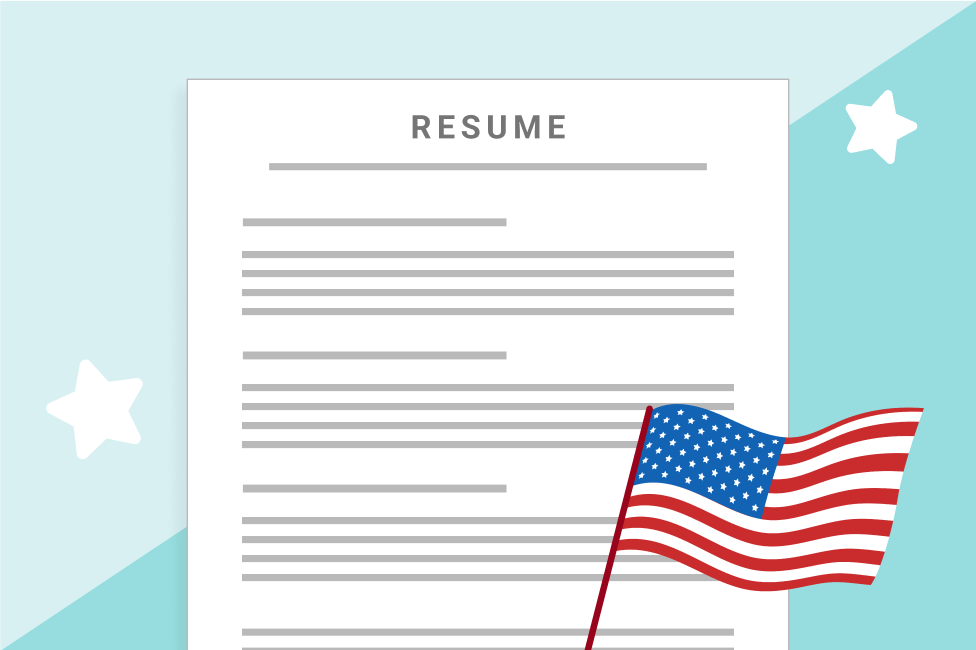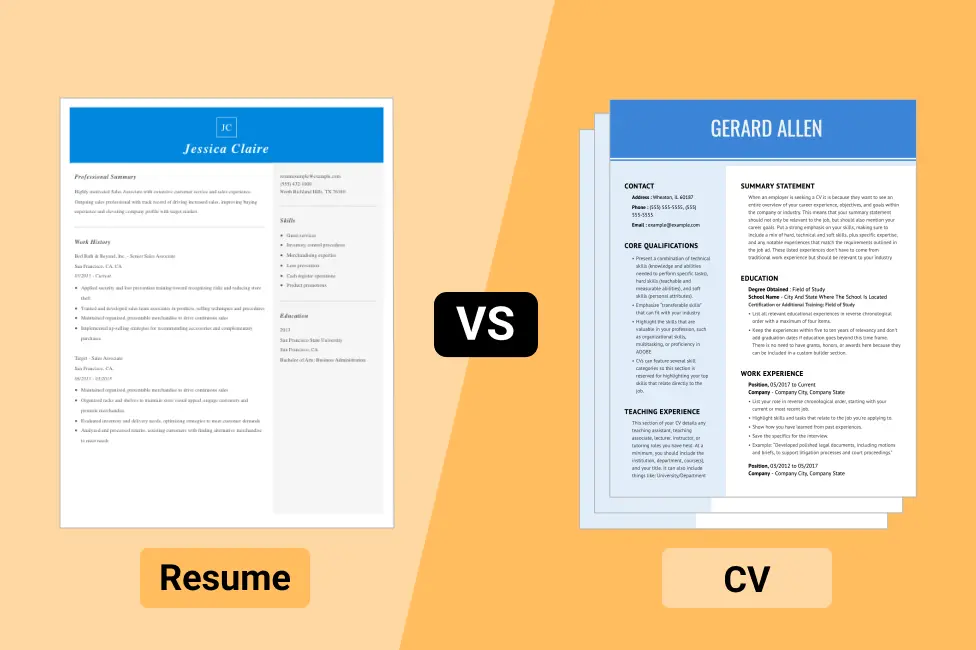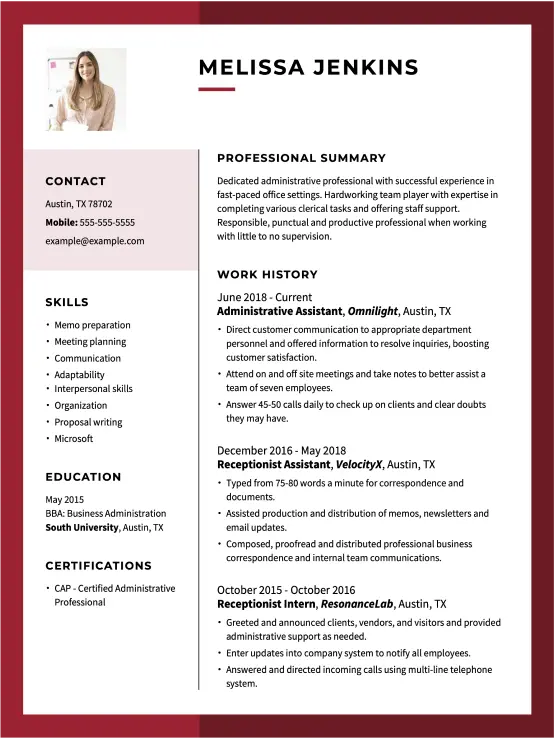U.S. Resume Format: How to Break Into the American Job Market
Apply to jobs in America confidently with our U.S. resume format templates. Learn how to optimize your resume for the U.S. job market with our tips and writing guide.
What is a U.S. Resume Format?
A U.S. resume format is a standard layout commonly used by job seekers to create resumes in the American job market.
Some of the key specifics of a U.S. resume format include:
- Resume length: one to three pages long; one pager per 10 years of experience.
- American English, not UK English. For instance, “labor” instead of “labour.”
- Five main resume sections: contact information, resume profile, work experience, skills and education.
U.S. resume formats do not include:
- Personal information such as your gender, age, marital status, birthday, children, profile picture or personal identification numbers.
- References listed on the resume; only provide references in a separate document if employers request them.
Check out this U.S. resume format example to better visualize how your resume should look:
Software Developer
If you want to navigate the U.S. job market successfully, you’ll need to follow these rules when writing your resume. However, if you’re going to get a head start in your job search, take advantage of our Resume Builder and create a custom resume in minutes!
How to Write a U.S. Format Resume
If you want to write a resume on your own, we’ve created this easy-to-follow guide for using the U.S. resume format.
Step 1: Choose the Appropriate Resume Format.
One thing you should know about U.S. resumes is that they follow one of the three recruiter-approved resume formats: chronological, functional or combination.
- Chronological resumes are the most common format in the U.S. job market. They focus on the work experience listed in reverse chronological order and are best for candidates with 10+ years of experience.
- Functional resumes are less popular but are ideal for job seekers with little to no experience, such as students, recent graduates or entry-level applicants.
- Combination resumes, as the name suggests, combine features of the chronological and functional formats, balancing the focus on the work experience and skills section.
Step 2: Format Your Contact Information Correctly.
The U.S. resume format always includes a header with your name and contact details.
Your resume’s contact information section should also include:
- Your phone number.
- Email.
- Location (city and state).
- Linkedin, portfolio or professional website (optional).
Step 3: Write a Compelling Resume Summary or Objective.
The resume profile is one of the first sections recruiters will evaluate when reviewing your resume.
You can take two approaches when writing this resume section: the resume summary or the objective statement.
A resume summary is the most widely used strategy, listing your most relevant qualifications, skills and experiences.
The objective statement also features relevant qualifications and shares your career plans and aspirations.
Here’s an example of a U.S. format resume summary:
Now check out this example of a U.S. format resume objective statement:
Step 4: Write Your Work Experience Section.
To write a work experience section following the U.S. resume format rules, you must:
- List your jobs in reverse chronological order.
- Include your job title, company name, employment dates and city and state.
- Add a few bullet points detailing your achievements in each role (except in the functional format).
Here’s an example you can reference:
Data Analyst
Tumen Corp — New York, NY
June 2021 – Present
- Analyzed and interpreted complex datasets to identify key trends, patterns and insights, leading to 15% increase in overall sales performance.
- Developed and maintained automated dashboards using Tableau and Power BI, improving real-time data visibility for senior management.
- Conducted A/B testing on marketing campaigns, resulting in 23% improvement in customer engagement and a 12% reduction in churn rate.
Step 5: Curate a Strong List of Skills.
A simple way to get recruiters to notice your resume is to add relevant skills to different sections of your resume.
Some of the most in-demand professional skills in the U.S. are:
- Data analysis
- Sales
- Leadership
- Machine learning
- User experience (UX) design
- Web development
- Project management
- Cloud computing
- Communication skills
- Search engine optimization (SEO)
- Data Science
- Social media marketing
Step 6: Showcase Your Education.
Most professions in the U.S., even for entry-level positions, require you to have a bachelor’s degree. Therefore, you should always have an education section in your U.S. format resume that includes the following:
- The name of your degree.
- The name of the university or institute.
- Location (city and state).
Some optional information you may add can be:
- Expected graduation date.
- GPA.
- Honors and awards.
- Relevant coursework.
- Projects.
Here’s an example of an education section in a U.S. resume format:
Education
Bachelor of Science in Computer Science
University of California, Berkeley — Berkeley, CA
Graduated: May 2020
- GPA: 3.8/4.0
- Relevant Coursework: Data Structures, Algorithms, Software Engineering, Operating Systems, Database Management, Machine Learning
- Honors and Awards: Dean’s List (2017-2020), UC Berkeley Coding Challenge Winner (2019)
What Not to Include in a U.S. Resume Format
When writing a resume following the U.S. format, what you must leave out of your resume is just as important as what you must include.
Here’s a list of everything you shouldn’t include:
Profile pictures: U.S. resumes don’t include photos of yourself to prevent any biases.
Personal information regarding your race, age, gender, marital status, ethnicity or nationality.
Identification numbers like your license number, passport or social security number.
Your full street address to prevent. You should keep your home location private until employed.
Irrelevant work experience: Unlike curriculum vitae (CV), there’s no need to list every job you’ve ever had; instead, focus on the job titles related to your desired occupation.
Hobbies and interests are uncommon in U.S. format resumes. Only include them if they add relevant skills for the role you want.
References should never appear in your U.S. resume. If an employer requires them, sharing them in a separate document is best.
Salary information: Do not include current or past salary information or salary expectations. Salary discussions typically occur during the interview or offer stages.
High school information: A common resume mistake to avoid is sharing any high school information if you possess a college degree.
Long paragraphs: Avoid large swaths of text and instead opt for bullet points to break down your text and make your U.S. resume format more readable.
Personal pronouns and articles like “I,” “my,” “a,” and “the” are usually left out of resumes to make the content more concise.
Tips for the U.S. Job Market
Navigating the American job market can be challenging, especially if you’re new to the workforce or coming from a different country. Here are some essential tips to help you stand out and succeed in your job search:
Tailor your resume and cover letter to the job: Avoid using a generic resume and cover letter. Instead, tailor your application to each job by highlighting the skills and experiences most relevant to the position.
Incorporate keywords from the job description: Scan for critical skills and qualifications in your desired role’s job advertisement to add them to your resume. Many companies use applicant tracking systems (ATS) that scan resumes for specific terms before they reach a human recruiter.
Build a professional online presence: Create and regularly update a LinkedIn profile, and use it to showcase your work experience, skills and professional accomplishments. Ensure your online presence is professional, and adjust privacy settings on any personal content you wouldn’t want an employer to see.
Network strategically: Participate in networking events, job fairs and industry conferences in person and online. Contact professionals in your field for informational interviews; these conversations may provide valuable insights into the industry and lead to job opportunities.
Understand the importance of soft skills: Strong communication skills, adaptability and cultural fit are highly valuable in the U.S. workplace. Be clear and professional in both verbal and written communications. Demonstrate your ability to adapt to new situations and technologies. Research the company’s values and work environment to ensure you meet their expectations.
Prepare for interviews: Practice common interview questions like “Tell me about yourself,” “What are your strengths and weaknesses?” and “Why do you want to work here?” At the end of the interview, ask thoughtful questions about the company and the role to demonstrate your interest and engagement.
Follow up after the interview: Within 24 hours of your interview, send a personalized thank-you email to each interviewer. Express your appreciation for their time and reiterate your interest in the position. If you haven’t heard back within the timeline provided, it’s appropriate to follow up with a polite email to inquire about the status of your application.
Understand employment laws and benefits: Familiarize yourself with U.S. employment laws, including your rights as an employee, overtime rules and anti-discrimination laws. Besides salary, consider negotiating other benefits like health insurance, retirement plans and vacation time.
Continue learning and upskilling: Stay competitive by earning relevant certifications or taking courses that enhance your skills. Keep up with industry trends and developments to keep your skills and knowledge current.
PRO TIP
Want to make sure your current resume is apt for the U.S. job market and applicant tracking systems? Run it through our ATS Resume Checker, and we’ll check for 30+ common resume mistakes.







